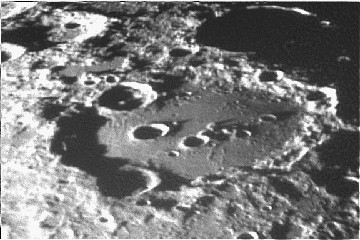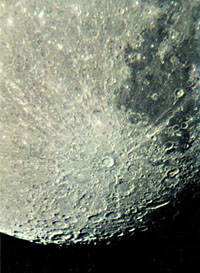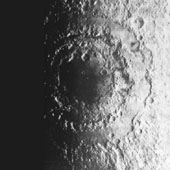impact feature

Figure 1. Clavius and other impact craters on the Moon.

Figure 2. A bright ray crater – Tycho crater on the Moon.
An impact feature is any feature on the surface of a planet, moon, or asteroid that has resulted from a past collision with another object. Among the types or subtypes identified are impact craters, impact basins, multiringed basins, and palimpsests.
Impact crater
An impact crater is a crater formed by the high-speed impact of a meteoroid, asteroid, or comet with a solid surface (Figure 1). Craters are a common feature on most moons (an exception is Io), asteroids, and rocky planets, and range in size from a few centimeters to over 1,000 kilometers across, in the case a large impact basin. There is a general morphological progression from large to small craters: large craters might have several rings and smooth floors; intermediate craters tend to have a central peak (formed by melting and rebounding of the crust) and smooth floors; small craters have a simple bowl-shaped floor that is rough. Because impact craters degrade at different rates depending on their environment, they are valuable indicators of the age of a surface and the extent to which resurfacing has taken place. On Earth, for example, craters are rapidly degraded and destroyed by weathering processes; about 120 are known, with diameters ranging from 150 meters to 180 kilometers. One of the best preserved and most impressive is the Barringer crater, near Winslow in northern Arizona. On Mercury, by contrast, which lacks an atmosphere and is geologically inert, the landscape is peppered with craters dating back over 4 billion years.
A secondary crater is a small crater formed by ejecta thrown out of a larger impact crater. Secondary craters tend to cluster in a ring around the main crater, the greatest number lying a bit more than one crater diameter away on the Moon, but closer on Mercury because of the higher surface gravity. Ejecta falling near to the main crater tends to be moving too slowly to form craters but instead piles up as an ejecta blanket.
Ray crater
A ray crater is a relatively young impact crater from which radiate streaks of material thrown out during the collision that created the crater (Figure 2). Bright ray craters are found on various bodies in the Solar System including the Moon, Mercury, Ganymede, Callisto, and Oberon. The lunar craters Tycho (shown in the accompanying photo) and Copernicus are particularly conspicuous examples, with bright rays extending for hundreds of kilometers.
Dark ray craters are rare and have been seen mostly on Jupiter's largest moon Ganymede, e.g. the 30-kilometer-wide Kittu.
Impact basin
An impact basin is an impact crater that has a rim diameter greater than 300 km. Impact basins are produced by such violent impacts that they are always associated with extensive faulting and other deformations of the crust, and very large ejecta blankets. Over 40 impact basins have been identified on the Moon, the largest of which is the Imbrium Basin.
Multiringed basin
A multiringed basin is a large impact feature surrounded by a series of concentric rings. Examples include Mare Orientale on the Moon, the Caloris Basin on Mercury, and Valhalla and Asgard on Callisto. The rings are similar to the ripples caused by throwing a stone into a pond; they are the peaks and troughs of rock made molten by the impact, which then froze in position as it cooled.
 |
| Mare Orientale on the Moon
|
Palimpsest
In the context of planetary astronomy, a palimpsest is an ancient, relatively bright, circular feature on the surface of a dark icy moon, such as Ganymede or Callisto. Palimpsests lack the relief associated with normal craters and are thought to be impact craters of which the topographic relief has been eliminated by viscous relaxation (creep) of the icy surface, probably during the impact itself. Typical is Ganymede's 340-kilometer-wide Memphis Facula. Such structures hold important clues to the early thermal history and composition of the bodies on which they are found. The original meaning, "scraped again," refers to a manuscript on a waxen tablet or other writing material from which an early text was removed and then written over. The value of palimpsests, in both planetary astronomy and literature, is that, they preserve a record of the past in the form of something that is partly hidden from view.
In the traditional sense, a palimpsest is a painting that has been obscured and covered over by a second image. Palimpsests are sometimes found in the works of Old Masters who, dissatisfied by their own work, economized by simply painting over their first picture. They have also been used as a means of stealing a valuable old painting. A painting over a master work appears to be innocuous, or very bad, and can subsequently be removed to reveal the original work.
 |
| Memphis Facula, on Ganymede..
|


